Controllable Synthesis of Fe2O3/Nickel Cobaltite Electrocatalyst to Enhance Oxidation of Small Molecules
Abstract
:1. Introduction
2. Results Section
2.1. Structural and Surface Characterization
2.2. Electrochemical Activity Fe@NiCo2O4/NF
2.2.1. Urea Electro-Oxidation
2.2.2. Ethanol Electro-Oxidation
2.2.3. Ethylene Glycol Electro-Oxidation
2.3. Effect of Scan Rate and Surface Durability
3. Experimental Section
3.1. Instruments and Devices
3.2. Synthesis of Fe@NiCo2O4/NF
3.3. Electrochemical System
4. Conclusions
Author Contributions
Funding
Data Availability Statement
Acknowledgments
Conflicts of Interest
References
- Talebian-Kiakalaieh, A.; Amin, N.A.S.; Hezaveh, H. Glycerol for renewable acrolein production by catalytic dehydration. Renew. Sustain. Energy Rev. 2014, 40, 28–59. [Google Scholar] [CrossRef]
- Talebian-Kiakalaieh, A.; Amin, N.A.S.; Najaafi, N.; Tarighi, S. A review on the catalytic acetalization of bio-renewable glycerol to fuel additives. Front. Chem. 2018, 6, 573. [Google Scholar] [CrossRef] [PubMed]
- Höök, M.; Tang, X. Depletion of fossil fuels and anthropogenic climate change—A review. Energy Policy 2013, 52, 797–809. [Google Scholar] [CrossRef]
- Perera, F.; Nadeau, K. Climate change, fossil-fuel pollution, and children’s health. N. Engl. J. Med. 2022, 386, 2303–2314. [Google Scholar] [CrossRef] [PubMed]
- Carrette, L.; Friedrich, K.A.; Stimming, U. Fuel cells: Principles, types, fuels, and applications. ChemPhysChem 2000, 1, 162–193. [Google Scholar] [CrossRef]
- Lucia, U. Overview on fuel cells. Renew. Sustain. Energy Rev. 2014, 30, 164–169. [Google Scholar] [CrossRef]
- Kordesch, K.; Simader, G. Fuel Cells and Their Applications; Wiley-VCH: Weinheim, Germany, 1996. [Google Scholar]
- Cui, G.; Song, S.; Shen, P.K.; Kowal, A.; Bianchini, C. First-principles considerations on catalytic activity of Pd toward ethanol oxidation. J. Phys. Chem. C 2009, 113, 15639–15642. [Google Scholar] [CrossRef]
- Song, H.M.; Anjum, D.H.; Sougrat, R.; Hedhili, M.N.; Khashab, N.M. Hollow Au@Pd and Au@Pt core–shell nanoparticles as electrocatalysts for ethanol oxidation reactions. J. Mater. Chem. 2012, 22, 25003–25010. [Google Scholar] [CrossRef]
- Urbańczyk, E.; Jaroń, A.; Simka, W. Electrocatalytic oxidation of urea on a sintered Ni–Pt electrode. J. Appl. Electrochem. 2017, 47, 133–138. [Google Scholar] [CrossRef]
- Hefnawy, M.A.; Nafady, A.; Mohamed, S.K.; Medany, S.S. Facile green synthesis of Ag/carbon nanotubes composite for efficient water splitting applications. Synth. Met. 2023, 294, 117310. [Google Scholar] [CrossRef]
- Hefnawy, M.A.; Fadlallah, S.A.; El-Sherif, R.M.; Medany, S.S. Competition between enzymatic and non-enzymatic electrochemical determination of cholesterol. J. Electroanal. Chem. 2023, 930, 117169. [Google Scholar] [CrossRef]
- Al-Kadhi, N.S.; Hefnawy, M.A.; Nafee, S.S.; Alamro, F.S.; Pashameah, R.A.; Ahmed, H.A.; Medany, S.S. Zinc Nanocomposite Supported Chitosan for Nitrite Sensing and Hydrogen Evolution Applications. Polymers 2023, 15, 2357. [Google Scholar] [CrossRef]
- Galal, A.; Atta, N.F.; Hefnawy, M.A. Lanthanum nickel oxide nano-perovskite decorated carbon nanotubes/poly (aniline) composite for effective electrochemical oxidation of urea. J. Electroanal. Chem. 2020, 862, 114009. [Google Scholar] [CrossRef]
- Li, N.; Sun, L.; Li, Q.; Xia, T.; Huo, L.; Zhao, H. Electrode properties of CuBi2O4 spinel oxide as a new and potential cathode material for solid oxide fuel cells. J. Power Sources 2021, 511, 230447. [Google Scholar] [CrossRef]
- Lewis, M.J.; Zhu, J.H. A Process to Synthesize (Mn , Co)3O4 Spinel Coatings for Protecting SOFC Interconnect Alloys. Electrochem. Solid State Lett. 2011, 14, B9. [Google Scholar] [CrossRef]
- Zhang, Q.; Martin, B.E.; Petric, A. Solid oxide fuel cell composite cathodes prepared by infiltration of copper manganese spinel into porous yttria stabilized zirconia. J. Mater. Chem. 2008, 18, 4341–4346. [Google Scholar] [CrossRef]
- Galal, A.; Atta, N.F.; Hefnawy, M.A. Voltammetry study of electrocatalytic activity of lanthanum nickel perovskite nanoclusters-based composite catalyst for effective oxidation of urea in alkaline medium. Synth. Met. 2020, 266, 116372. [Google Scholar] [CrossRef]
- Atta, N.F.; El-Sherif, R.M.A.; Hassan, H.K.; Hefnawy, M.A.; Galal, A. Conducting Polymer-Mixed Oxide Composite Electrocatalyst for Enhanced Urea Oxidation. J. Electrochem. Soc. 2018, 165, J3310–J3317. [Google Scholar] [CrossRef]
- Zhang, T.; Yang, K.; Wang, C.; Li, S.; Zhang, Q.; Chang, X.; Li, J.; Li, S.; Jia, S.; Wang, J. Nanometric Ni5P4 clusters nested on NiCo2O4 for efficient hydrogen production via alkaline water electrolysis. Adv. Energy Mater. 2018, 8, 1801690. [Google Scholar] [CrossRef]
- Cheng, J.P.; Wang, W.D.; Wang, X.C.; Liu, F. Recent research of core–shell structured composites with NiCo2O4 as scaffolds for electrochemical capacitors. Chem. Eng. J. 2020, 393, 124747. [Google Scholar] [CrossRef]
- Liu, X.Y.; Zhang, Y.Q.; Xia, X.H.; Shi, S.J.; Lu, Y.; Wang, X.L.; Gu, C.D.; Tu, J.P. Self-assembled porous NiCo2O4 hetero-structure array for electrochemical capacitor. J. Power Sources 2013, 239, 157–163. [Google Scholar] [CrossRef]
- Ding, Q.; Zou, X.; Ke, J.; Dong, Y.; Cui, Y.; Lu, G.; Ma, H. S-scheme 3D/2D NiCo2O4@ g-C3N4 hybridized system for boosting hydrogen production from water splitting. Renew. Energy 2023, 203, 677–685. [Google Scholar] [CrossRef]
- Medany, S.S.; Hefnawy, M.A. Nickel–cobalt oxide decorated Chitosan electrocatalyst for ethylene glycol oxidation. Surf. Interfaces 2023, 40, 103077. [Google Scholar] [CrossRef]
- Alamro, F.S.; Hefnawy, M.A.; Nafee, S.S.; Al-Kadhi, N.S.; Pashameah, R.A.; Ahmed, H.A.; Medany, S.S. Chitosan Supports Boosting NiCo2O4 for Catalyzed Urea Electrochemical Removal Application. Polymers 2023, 15, 3058. [Google Scholar] [CrossRef] [PubMed]
- Ding, R.; Qi, L.; Jia, M.; Wang, H. Facile synthesis of mesoporous spinel NiCo2O4 nanostructures as highly efficient electrocatalysts for urea electro-oxidation. Nanoscale 2014, 6, 1369–1376. [Google Scholar] [CrossRef] [PubMed]
- Sha, L.; Ye, K.; Wang, G.; Shao, J.; Zhu, K.; Cheng, K.; Yan, J.; Wang, G.; Cao, D. Hierarchical NiCo2O4 nanowire array supported on Ni foam for efficient urea electrooxidation in alkaline medium. J. Power Sources 2019, 412, 265–271. [Google Scholar] [CrossRef]
- Zhan, J.; Cai, M.; Zhang, C.; Wang, C. Synthesis of mesoporous NiCo2O4 fibers and their electrocatalytic activity on direct oxidation of ethanol in alkaline media. Electrochim. Acta 2015, 154, 70–76. [Google Scholar] [CrossRef]
- Almeida, T.S.; Garbim, C.; Silva, R.G.; De Andrade, A.R. Addition of iron oxide to Pt-based catalyst to enhance the catalytic activity of ethanol electrooxidation. J. Electroanal. Chem. 2017, 796, 49–56. [Google Scholar] [CrossRef]
- Hefnawy, M.A.; Medany, S.S.; El-Sherif, R.M.; Fadlallah, S.A. Green synthesis of NiO/Fe3O4@chitosan composite catalyst based on graphite for urea electro-oxidation. Mater. Chem. Phys. 2022, 290, 126603. [Google Scholar] [CrossRef]
- Aksaray, G.; Mert, M.E.; Mert, B.D.; Kardaş, G. Catalytic insights into methanol electrooxidation on Ni foam modified with Bi2O3-Acetylene black-rGO: Synthesis, characterization, and performance evaluation. Int. J. Hydrogen Energy 2024, article in press. [Google Scholar] [CrossRef]
- Wei, Z.; Wang, Q.; Qu, M.; Zhang, H. Rational Design of Nanosheet Array-Like Layered-Double-Hydroxide-Derived NiCo2O4 In Situ Grown on Reduced-Graphene-Oxide-Coated Nickel Foam for High-Performance Solid-State Supercapacitors. ACS Appl. Mater. Interfaces 2024, 16, 18734–18744. [Google Scholar] [CrossRef] [PubMed]
- Tsai, M.-H.; Chen, T.-C.; Juang, Y.; Hua, L.-C.; Huang, C. High catalytic performance of CuCo/nickel foam electrode for ammonia electrooxidation. Electrochem. Commun. 2020, 121, 106875. [Google Scholar] [CrossRef]
- Liang, Y.; Liu, Q.; Asiri, A.M.; Sun, X. Enhanced electrooxidation of urea using NiMoO4·xH2O nanosheet arrays on Ni foam as anode. Electrochim. Acta 2015, 153, 456–460. [Google Scholar] [CrossRef]
- Chen, C.; Wen, H.; Tang, P.-P.; Wang, P. Supported Ni@Ni2P core–shell nanotube Arrays on Ni foam for hydrazine electrooxidation. ACS Sustain. Chem. Eng. 2021, 9, 4564–4570. [Google Scholar] [CrossRef]
- Sha, L.; Ye, K.; Wang, G.; Shao, J.; Zhu, K.; Cheng, K.; Yan, J.; Wang, G.; Cao, D. Rational design of NiCo2S4 nanowire arrays on nickle foam as highly efficient and durable electrocatalysts toward urea electrooxidation. Chem. Eng. J. 2019, 359, 1652–1658. [Google Scholar] [CrossRef]
- Li, Y.; Hai, Z.; Hou, X.; Xu, H.; Zhang, Z.; Cui, D.; Xue, C.; Zhang, B. Self-Assembly of 3D Fennel-Like Co3O4 with Thirty-Six Surfaces for High Performance Supercapacitor. J. Nanomater. 2017, 2017, 1404328. [Google Scholar] [CrossRef]
- Vijayan, S.; Narasimman, R.; Prabhakaran, K. A carbothermal reduction method for the preparation of nickel foam from nickel oxide and sucrose. Mater. Lett. 2016, 181, 268–271. [Google Scholar] [CrossRef]
- Geaney, H.; McNulty, D.; O’Connell, J.; Holmes, J.D.; O’Dwyer, C. Assessing Charge Contribution from Thermally Treated Ni Foam as Current Collectors for Li-Ion Batteries. J. Electrochem. Soc. 2016, 163, A1805. [Google Scholar] [CrossRef]
- Cai, L.; Li, Y.; Xiao, X.; Wang, Y. The electrochemical performances of NiCo2O4 nanoparticles synthesized by one-step solvothermal method. Ionics 2017, 23, 2457–2463. [Google Scholar] [CrossRef]
- Khalid, S.; Cao, C.; Wang, L.; Zhu, Y. Microwave Assisted Synthesis of Porous NiCo2O4 Microspheres: Application as High Performance Asymmetric and Symmetric Supercapacitors with Large Areal Capacitance. Sci. Rep. 2016, 6, 22699. [Google Scholar] [CrossRef]
- Waghmode, R.B.; Torane, A.P. Hierarchical 3D NiCo2O4 nanoflowers as electrode materials for high performance supercapacitors. J. Mater. Sci. Mater. Electron. 2016, 27, 6133–6139. [Google Scholar] [CrossRef]
- Qayoom, M.; Shah, K.A.; Pandit, A.H.; Firdous, A.; Dar, G.N. Dielectric and electrical studies on iron oxide (α-Fe2O3) nanoparticles synthesized by modified solution combustion reaction for microwave applications. J. Electroceram. 2020, 45, 7–14. [Google Scholar] [CrossRef]
- Xu, S.; Habib, A.H.; Gee, S.H.; Hong, Y.K.; McHenry, M.E. Spin orientation, structure, morphology, and magnetic properties of hematite nanoparticles. J. Appl. Phys. 2015, 117, 17A315. [Google Scholar] [CrossRef]
- Das, R.; Witanachchi, C.; Nemati, Z.; Kalappattil, V.; Rodrigo, I.; García, J.Á.; Garaio, E.; Alonso, J.; Lam, V.D.; Le, A.-T.; et al. Magnetic Vortex and Hyperthermia Suppression in Multigrain Iron Oxide Nanorings. Appl. Sci. 2020, 10, 787. [Google Scholar] [CrossRef]
- Li, X.; Wei, W.; Wang, S.; Kuai, L.; Geng, B. Single-crystalline α-Fe2O3 oblique nanoparallelepipeds: High-yield synthesis, growth mechanism and structure enhanced gas-sensing properties. Nanoscale 2011, 3, 718–724. [Google Scholar] [CrossRef] [PubMed]
- Grosvenor, A.P.; Biesinger, M.C.; Smart, R.S.C.; McIntyre, N.S. New interpretations of XPS spectra of nickel metal and oxides. Surf. Sci. 2006, 600, 1771–1779. [Google Scholar] [CrossRef]
- Hengne, A.M.; Samal, A.K.; Enakonda, L.R.; Harb, M.; Gevers, L.E.; Anjum, D.H.; Hedhili, M.N.; Saih, Y.; Huang, K.-W.; Basset, J.-M. Ni–Sn-Supported ZrO2 Catalysts Modified by Indium for Selective CO2 Hydrogenation to Methanol. ACS Omega 2018, 3, 3688–3701. [Google Scholar] [CrossRef] [PubMed]
- Hu, X.; Tian, X.; Lin, Y.-W.; Wang, Z. Nickel foam and stainless steel mesh as electrocatalysts for hydrogen evolution reaction, oxygen evolution reaction and overall water splitting in alkaline media. RSC Adv. 2019, 9, 31563–31571. [Google Scholar] [CrossRef] [PubMed]
- Ma, J.; Guo, E.; Yin, L. Porous hierarchical spinel Mn-doped NiCo2O4 nanosheet architectures as high-performance anodes for lithium-ion batteries and electrochemical reaction mechanism. J. Mater. Sci. Mater. Electron. 2019, 30, 8555–8567. [Google Scholar] [CrossRef]
- Tong, X.; Pang, N.; Qu, Y.; Yan, C.; Xiong, D.; Xu, S.; Wang, L.; Chu, P.K. 3D urchin-like NiCo2O4 coated with carbon nanospheres prepared on flexible graphite felt for efficient bifunctional electrocatalytic water splitting. J. Mater. Sci. 2021, 56, 9961–9973. [Google Scholar] [CrossRef]
- Liu, Y.; Liu, P.; Qin, W.; Wu, X.; Yang, G. Laser modification-induced NiCo2O4-δ with high exterior Ni3+/Ni2+ ratio and substantial oxygen vacancies for electrocatalysis. Electrochim. Acta 2019, 297, 623–632. [Google Scholar] [CrossRef]
- Mi, L.; Wei, W.; Huang, S.; Cui, S.; Zhang, W.; Hou, H.; Chen, W. A nest-like Ni@Ni 1.4 Co1.6S2 electrode for flexible high-performance rolling supercapacitor device design. J. Mater. Chem. A 2015, 3, 20973–20982. [Google Scholar] [CrossRef]
- Marco, J.F.; Gancedo, J.R.; Gracia, M.; Gautier, J.L.; Ríos, E.; Berry, F.J. Characterization of the nickel cobaltite, NiCo2O4, prepared by several methods: An XRD, XANES, EXAFS, and XPS study. J. Solid State Chem. 2000, 153, 74–81. [Google Scholar] [CrossRef]
- Gwag, J.-S.; Sohn, Y.-K. Interfacial natures and controlling morphology of Co oxide nanocrystal structures by adding spectator Ni ions. Bull. Korean Chem. Soc. 2012, 33, 505–510. [Google Scholar] [CrossRef]
- Fierro, J.L.G.; Pena, M.A.; González Tejuca, L. An XPS and reduction study of PrCoO3. J. Mater. Sci. 1988, 23, 1018–1023. [Google Scholar] [CrossRef]
- Kim, K.S.; Davis, R.E. 1-Electron spectroscopy of the nickel-oxygen system. J. Electron Spectros. Relat. Phenom. 1972, 1, 251–258. [Google Scholar] [CrossRef]
- Kim, Y.J.; Park, C.R. Analysis of problematic complexing behavior of ferric chloride with N, N-dimethylformamide using combined techniques of FT-IR, XPS, and TGA/DTG. Inorg. Chem. 2002, 41, 6211–6216. [Google Scholar] [CrossRef] [PubMed]
- Allen, G.C.; Curtis, M.T.; Hooper, A.J.; Tucker, P.M. X-ray photoelectron spectroscopy of iron–oxygen systems. J. Chem. Soc. Dalt. Trans. 1974, 14, 1525–1530. [Google Scholar] [CrossRef]
- Li, J.; Wang, Y.; Xu, W.; Wang, Y.; Zhang, B.; Luo, S.; Zhou, X.; Zhang, C.; Gu, X.; Hu, C. Porous Fe2O3 nanospheres anchored on activated carbon cloth for high-performance symmetric supercapacitors. Nano Energy 2019, 57, 379–387. [Google Scholar] [CrossRef]
- Mallick, S.; Jana, P.P.; Raj, C.R. Asymmetric supercapacitor based on chemically coupled hybrid material of Fe2O3-Fe3O4 heterostructure and nitrogen-doped reduced graphene oxide. ChemElectroChem 2018, 5, 2348–2356. [Google Scholar] [CrossRef]
- Zhong, B.; Wang, C.; Yu, Y.; Xia, L.; Wen, G. Facile fabrication of carbon microspheres decorated with B(OH)3 and α-Fe2O3 nanoparticles: Superior microwave absorption. J. Colloid Interface Sci. 2017, 505, 402–409. [Google Scholar] [CrossRef]
- Mohapatra, S.; Pal, D.; Ghosh, S.K.; Pramanik, P. Design of superparamagnetic iron oxide nanoparticle for purification of recombinant proteins. J. Nanosci. Nanotechnol. 2007, 7, 3193–3199. [Google Scholar] [CrossRef] [PubMed]
- Ketteler, G.; Yamamoto, S.; Bluhm, H.; Andersson, K.; Starr, D.E.; Ogletree, D.F.; Ogasawara, H.; Nilsson, A.; Salmeron, M. The nature of water nucleation sites on TiO2(110) surfaces revealed by ambient pressure X-ray photoelectron spectroscopy. J. Phys. Chem. C 2007, 111, 8278–8282. [Google Scholar] [CrossRef]
- Mitchell, C.E.; Santos-Carballal, D.; Beale, A.M.; Jones, W.; Morgan, D.J.; Sankar, M.; de Leeuw, N.H. The role of surface oxidation and Fe–Ni synergy in Fe–Ni–S catalysts for CO2 hydrogenation. Faraday Discuss. 2021, 230, 30–51. [Google Scholar] [CrossRef] [PubMed]
- Li, L.; Ma, P.; Hussain, S.; Jia, L.; Lin, D.; Yin, X.; Lin, Y.; Cheng, Z.; Wang, L. FeS2/carbon hybrids on carbon cloth: A highly efficient and stable counter electrode for dye-sensitized solar cells. Sustain. Energy Fuels 2019, 3, 1749–1756. [Google Scholar] [CrossRef]
- Yamashita, T.; Hayes, P. Analysis of XPS spectra of Fe2+ and Fe3+ ions in oxide materials. Appl. Surf. Sci. 2008, 254, 2441–2449. [Google Scholar] [CrossRef]
- Hefnawy, M.A.; Medany, S.S.; El-Sherif, R.M.; El-Bagoury, N.; Fadlallah, S.A. High-performance IN738 superalloy derived from turbine blade waste for efficient ethanol, ethylene glycol, and urea electrooxidation. J. Appl. Electrochem. 2023, 53, 1337–1348. [Google Scholar] [CrossRef]
- Hasan, M.; Newcomb, S.B.; Razeeb, K.M. Porous core/shell Ni@NiO/Pt hybrid nanowire arrays as a high efficient electrocatalyst for alkaline direct ethanol fuel cells. J. Electrochem. Soc. 2012, 159, F203. [Google Scholar] [CrossRef]
- Ahmed, M.S.; Jeon, S. Synthesis and Electrocatalytic Activity Evaluation of Nanoflower Shaped Ni-Pd on Alcohol Oxidation Reaction. J. Electrochem. Soc. 2014, 161, F1300. [Google Scholar] [CrossRef]
- Wang, W.; Li, X.; Cheng, Y.; Zhang, M.; Zhao, K.; Liu, Y. An effective PtPdAuCuFe/C high-entropy-alloy applied to direct ethylene glycol fuel cells. J. Taiwan Inst. Chem. Eng. 2023, 143, 104714. [Google Scholar] [CrossRef]
- Hefnawy, M.A.; Fadlallah, S.A.; El-Sherif, R.M.; Medany, S.S. Synergistic effect of Cu-doped NiO for enhancing urea electrooxidation: Comparative electrochemical and DFT studies. J. Alloys Compd. 2021, 896, 162857. [Google Scholar] [CrossRef]
- Hefnawy, M.A.; Medany, S.S.; El-Sherif, R.M.; Fadlallah, S.A. NiO-MnOx/Polyaniline/Graphite Electrodes for Urea Electrocatalysis: Synergetic Effect between Polymorphs of MnOx and NiO. ChemistrySelect 2022, 7, e202103735. [Google Scholar] [CrossRef]
- Xu, C.; Shen, P.K.; Ji, X.; Zeng, R.; Liu, Y. Enhanced activity for ethanol electrooxidation on Pt–MgO/C catalysts. Electrochem. Commun. 2005, 7, 1305–1308. [Google Scholar] [CrossRef]
- Yu, Z.; Xu, J.; Amorim, I.; Li, Y.; Liu, L. Easy preparation of multifunctional ternary PdNiP/C catalysts toward enhanced small organic molecule electro-oxidation and hydrogen evolution reactions. J. Energy Chem. 2021, 58, 256–263. [Google Scholar] [CrossRef]
- Ramulifho, T.; Ozoemena, K.I.; Modibedi, R.M.; Jafta, C.J.; Mathe, M.K. Electrocatalytic oxidation of ethylene glycol at palladium-bimetallic nanocatalysts (PdSn and PdNi) supported on sulfonate-functionalised multi-walled carbon nanotubes. J. Electroanal. Chem. 2013, 692, 26–30. [Google Scholar] [CrossRef]
- Yang, X.; Yuan, Q.; Sheng, T.; Wang, X. Mesoporous Mo-doped PtBi intermetallic metallene superstructures to enable the complete electrooxidation of ethylene glycol. Chem. Sci. 2024, 15, 4349–4357. [Google Scholar] [CrossRef] [PubMed]
- Basumatary, P.; Lee, U.H.; Konwar, D.; Yoon, Y.S. An efficient tri-metallic anodic electrocatalyst for urea electro-oxidation. Int. J. Hydrogen Energy 2020, 45, 32770–32779. [Google Scholar] [CrossRef]
- Wu, F.; Eid, K.; Abdullah, A.M.; Niu, W.; Wang, C.; Lan, Y.; Elzatahry, A.A.; Xu, G. Unveiling one-pot template-free fabrication of exquisite multidimensional PtNi multicube nanoarchitectonics for the efficient electrochemical oxidation of ethanol and methanol with a great tolerance for CO. ACS Appl. Mater. Interfaces 2020, 12, 31309–31318. [Google Scholar] [CrossRef] [PubMed]
- Forslund, R.P.; Mefford, J.T.; Hardin, W.G.; Alexander, C.T.; Johnston, K.P.; Stevenson, K.J. Nanostructured LaNiO3 perovskite electrocatalyst for enhanced urea oxidation. ACS Catal. 2016, 6, 5044–5051. [Google Scholar] [CrossRef]
- Hefnawy, M.A.; Fadlallah, S.A.; El-Sherif, R.M.; Medany, S.S. Systematic DFT studies of CO-Tolerance and CO oxidation on Cu-doped Ni surfaces. J. Mol. Graph. Model. 2023, 118, 108343. [Google Scholar] [CrossRef]
- Foroutan Koudahi, M.; Naji, L. Hydrothermal synthesis of nickel foam-supported spinel ZnNi2O4 nanostructure as electrode materials for supercapacitors. Electrochim. Acta 2022, 434, 141314. [Google Scholar] [CrossRef]
- Ispas, A.; Matsushima, H.; Plieth, W.; Bund, A. Influence of a magnetic field on the electrodeposition of nickel–iron alloys. Electrochim. Acta 2007, 52, 2785–2795. [Google Scholar] [CrossRef]
- Yin, K.-M.; Lin, B.-T. Effects of boric acid on the electrodeposition of iron, nickel and iron-nickel. Surf. Coat. Technol. 1996, 78, 205–210. [Google Scholar] [CrossRef]

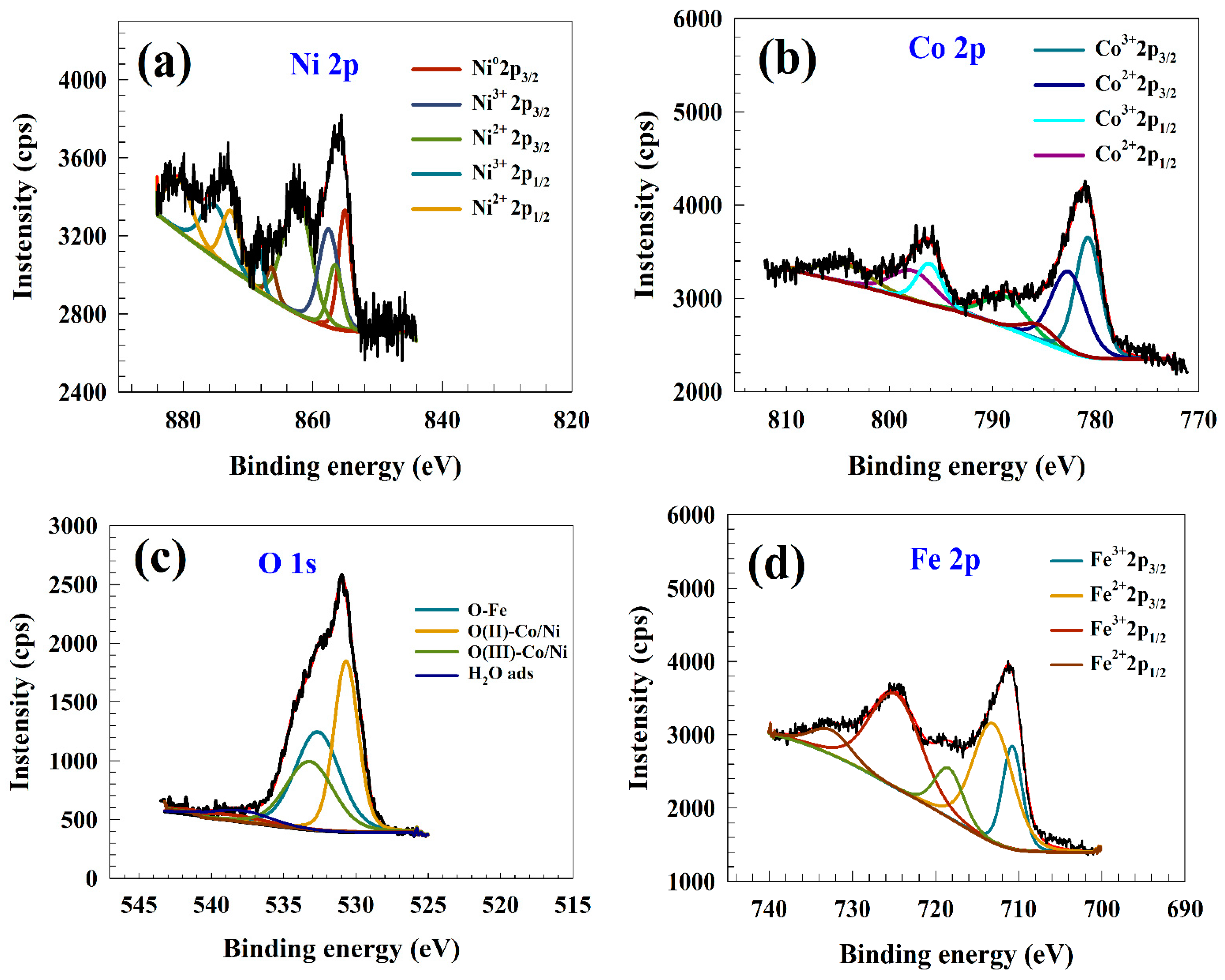


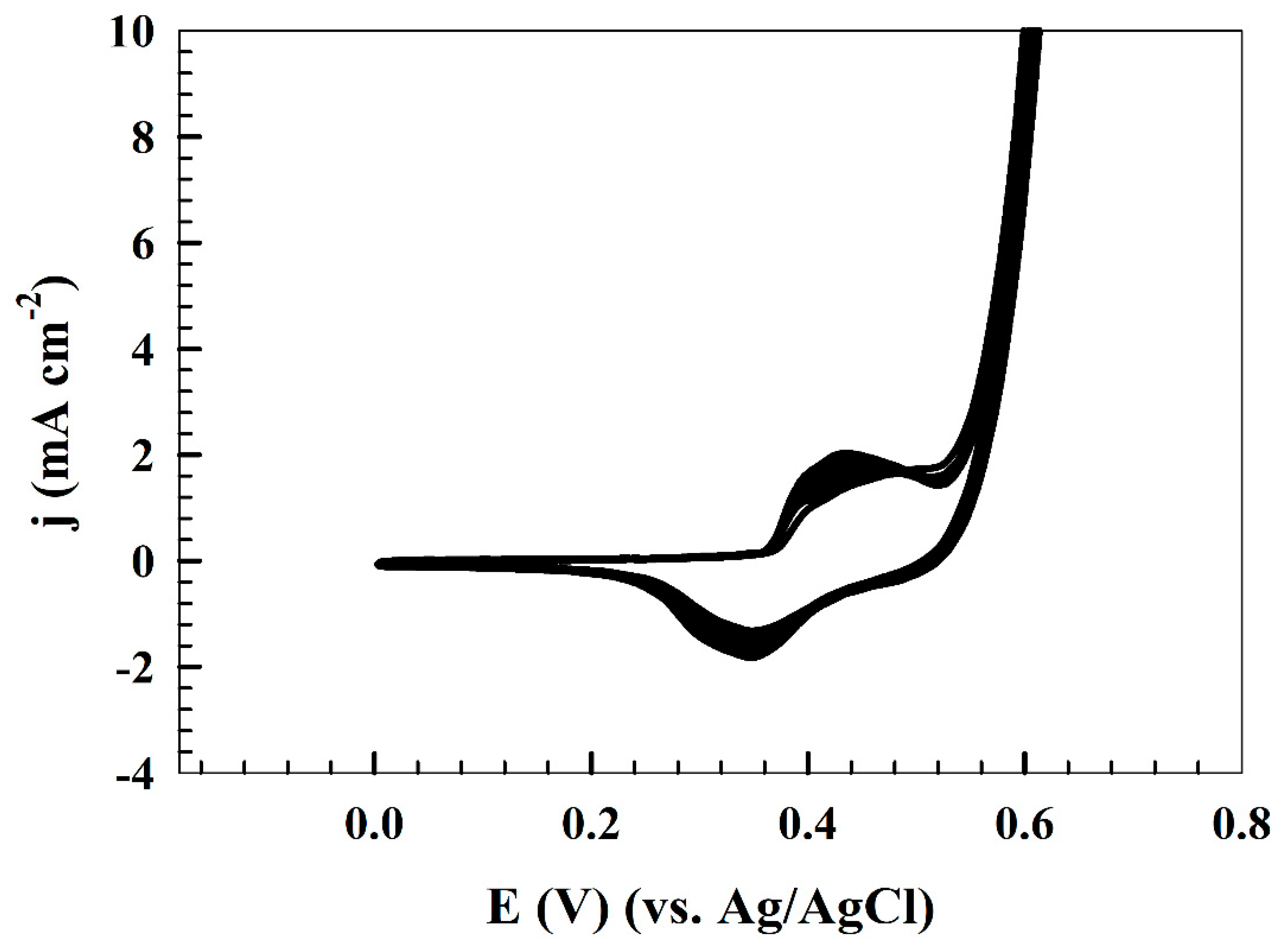
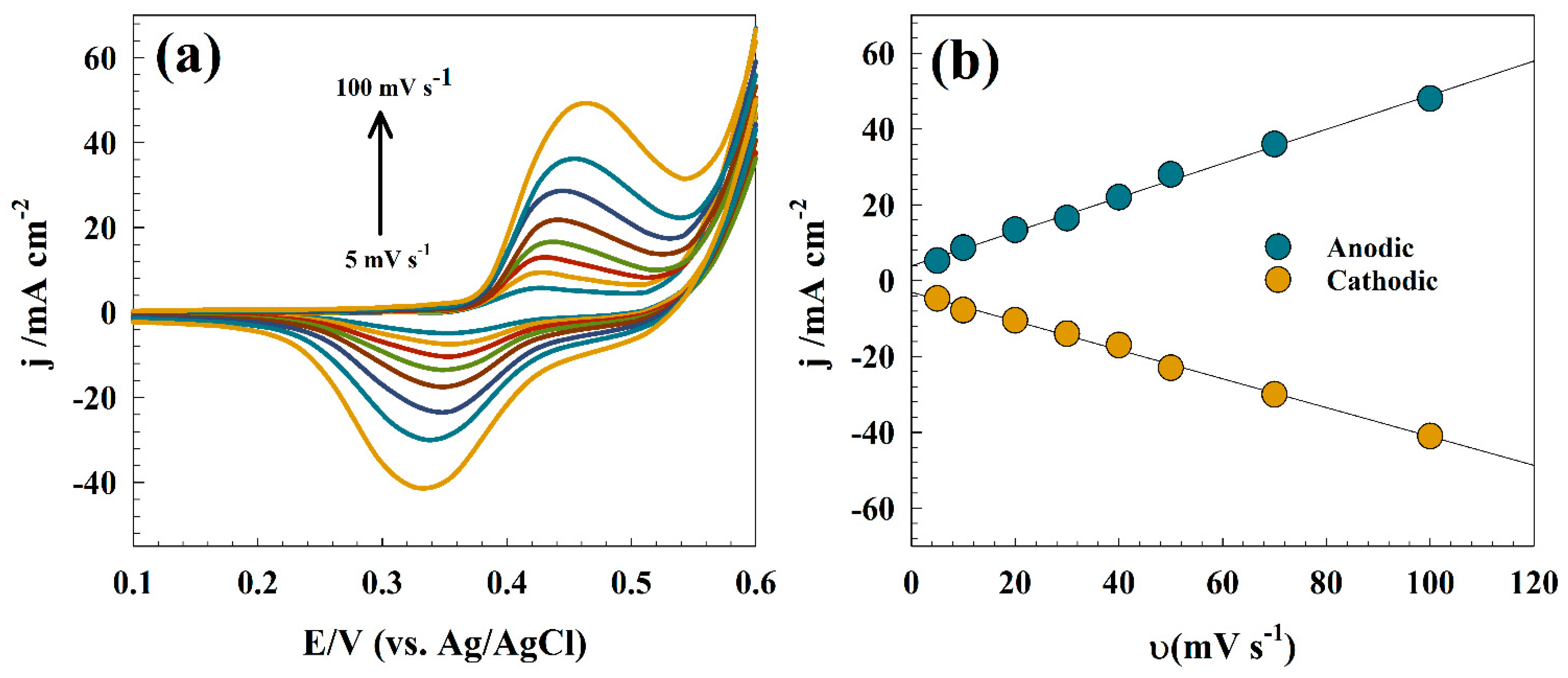
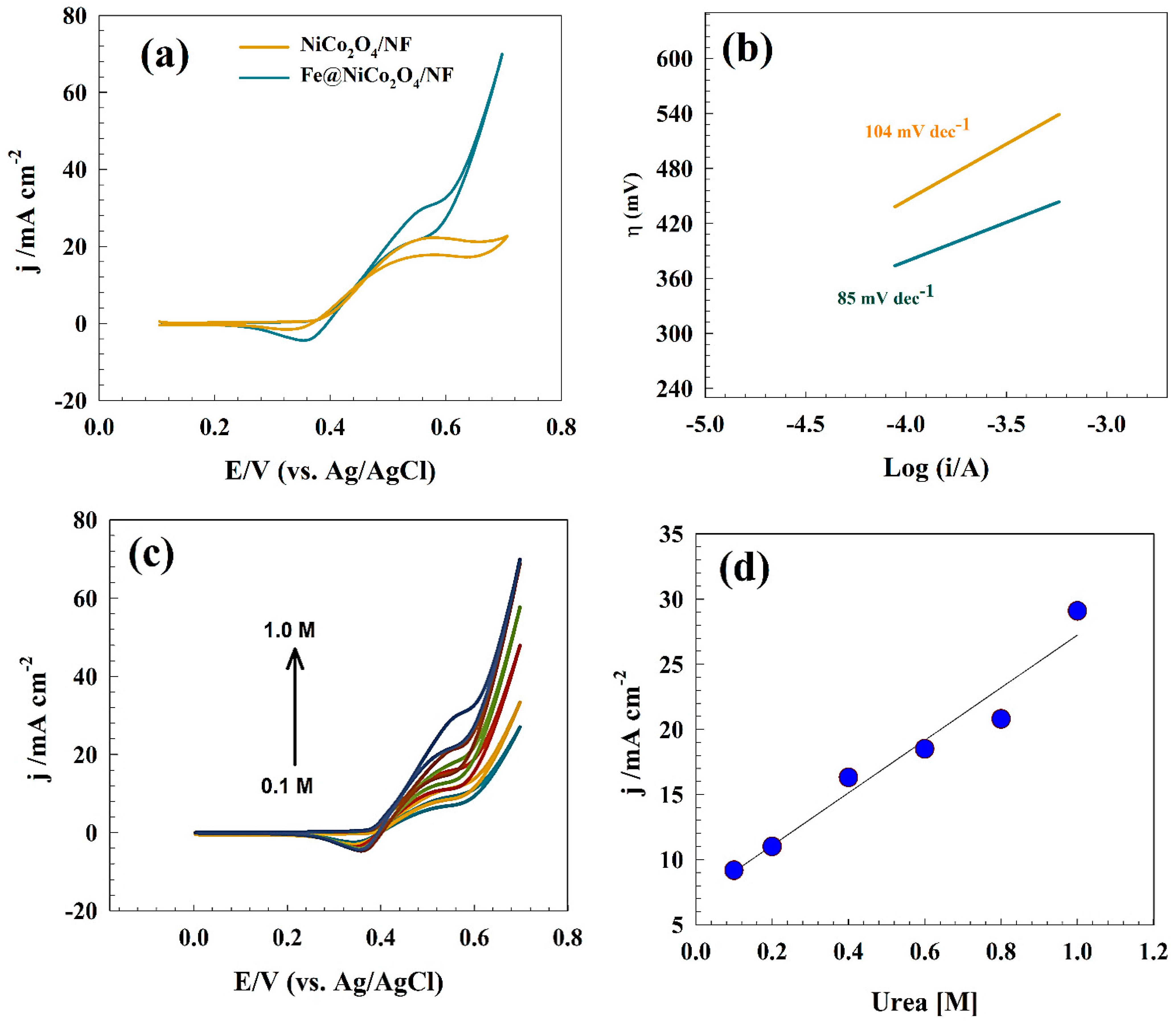



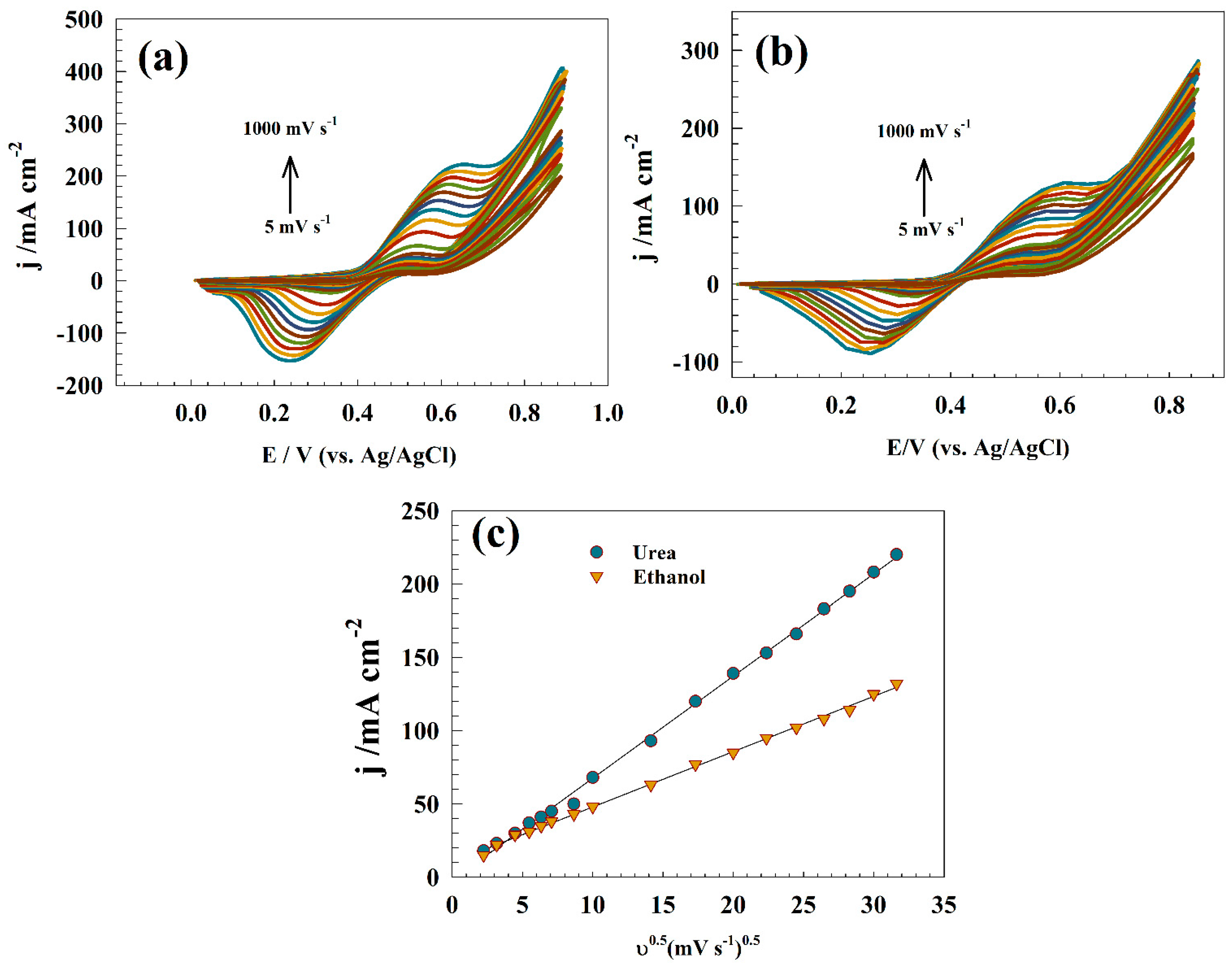
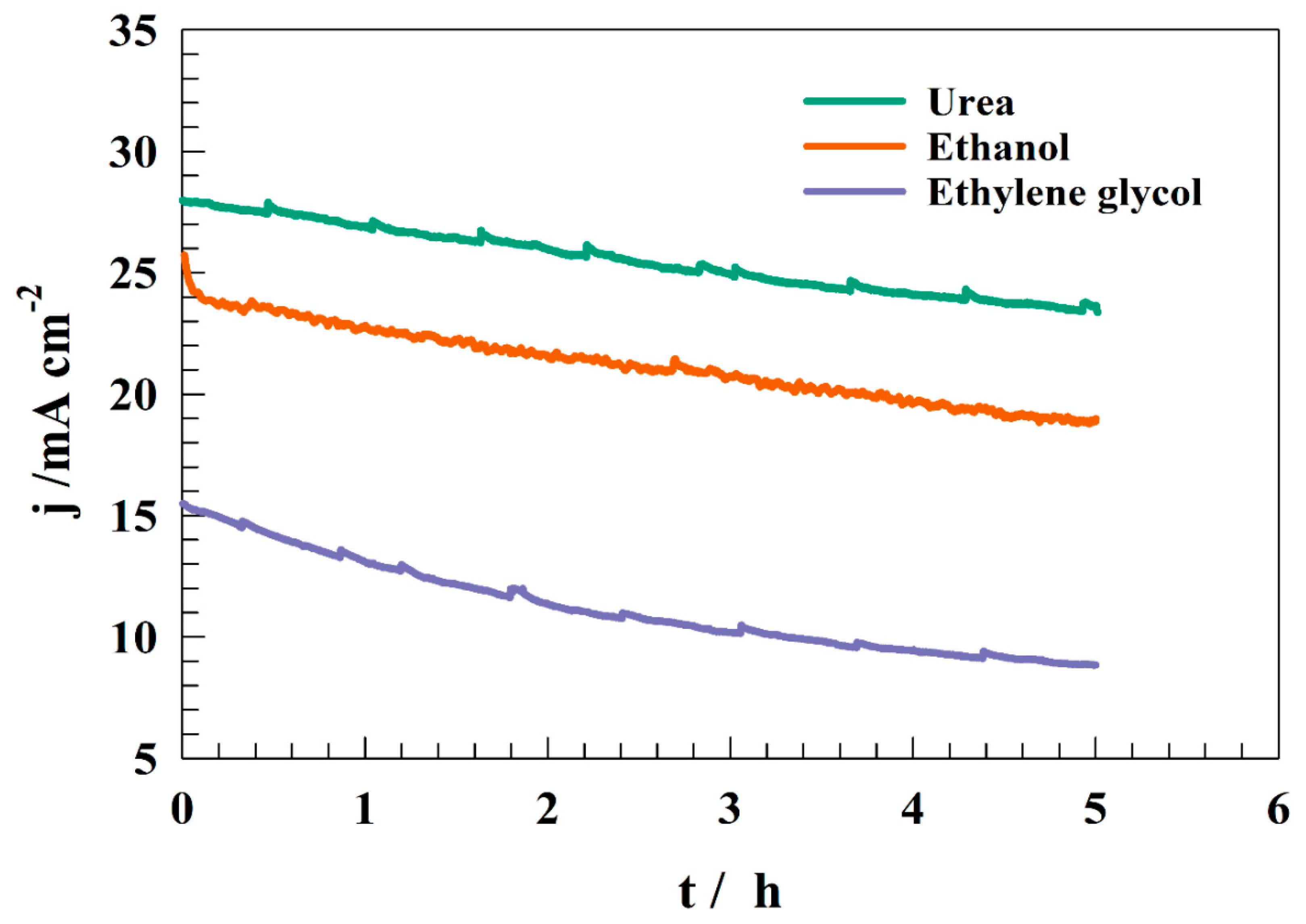
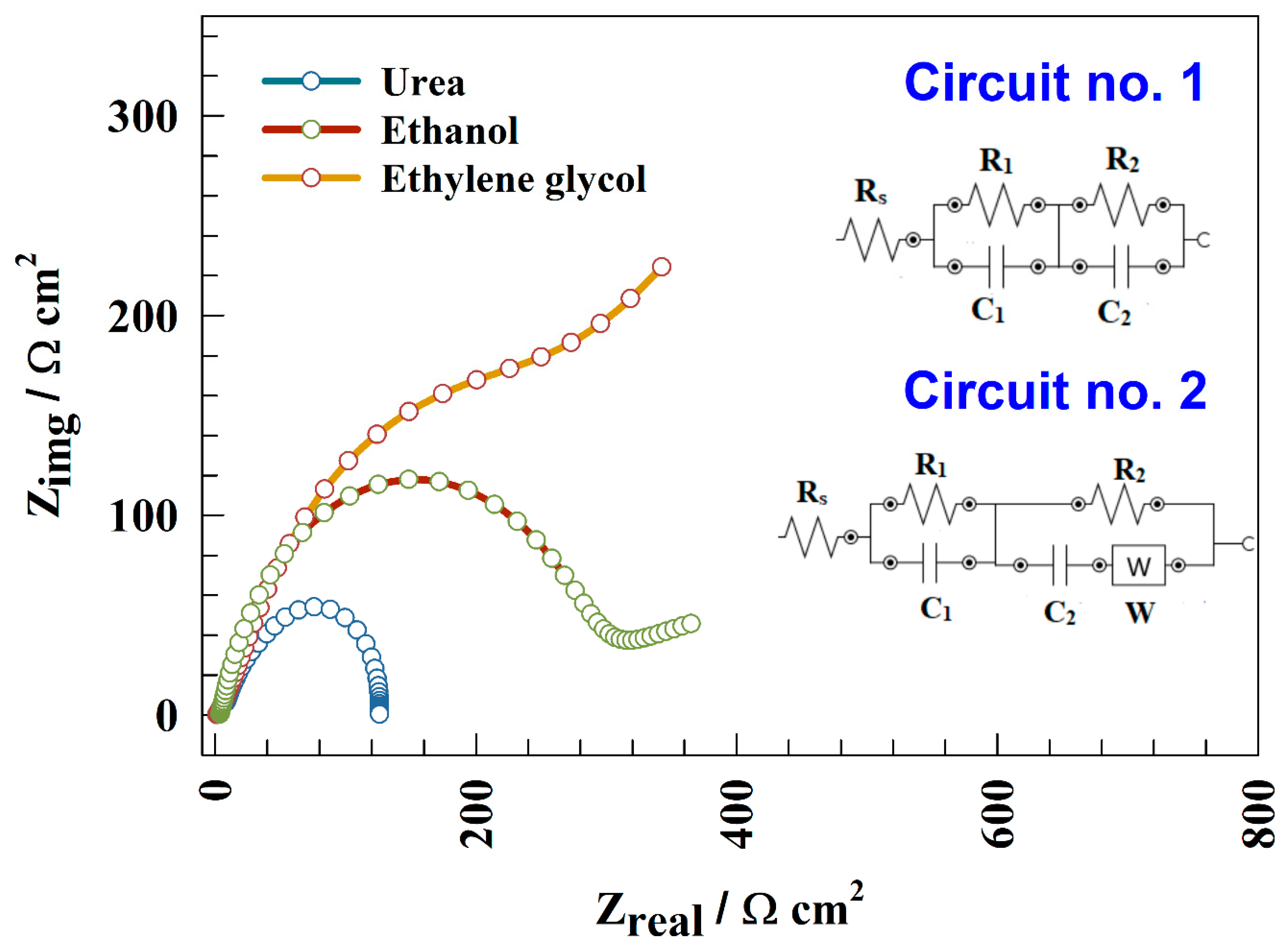
| Anode Material | Fuel | Electrolyte Concentration (mol L−1) | Fuel Concentration (mol L−1) | Sweep Rate (mV s−1) | Ip (mA cm−2) | Tafel Slope (mV/dec) | Ep (V) | Reference |
|---|---|---|---|---|---|---|---|---|
| Fe@NiCo2O4/NF | Urea | 1.0 | 1.0 | 20 | 31 | 85 | 0.55 (vs. Ag/AgCl) | This work |
| Fe@NiCo2O4/NF | Ethanol | 1.0 | 1.0 | 20 | 27 | 91 | 0.55 (vs. Ag/AgCl) | This work |
| Fe@NiCo2O4/NF | Ethylene glycol | 1.0 | 1.0 | 20 | 17 | 120 | 0.58 (vs. Ag/AgCl) | This work |
| Cu@NiO/GC | Urea | 0.5 | 0.3 | 20 | 32 | 48 | 0.58 (vs. Ag/AgCl) | [72] |
| NiO@MnOx/Pani/Gr | Urea | 1.0 | 0.3 | 50 | 20 | 73 | 0.5 (vs. Ag/AgCl) | [73] |
| IN738 supper alloy | Ethanol | 1.0 | 1.0 | 20 | 29 | 52 | 0.55 (vs. Ag/AgCl) | [68] |
| Pt/C | Ethanol | 1.0 | 1.0 | 50 | 4.9 | 132 | −0.1 (vs. Hg/HgO) | [74] |
| Pt–MgO | Ethanol | 1.0 | 1.0 | 50 | 27.1 | 129 | −0.2 (vs. Hg/HgO) | [74] |
| PdNiP/C | Ethylene glycol | 1.0 | 1.0 | 20 | 31 | - | −0.3 (vs. SCE) | [75] |
| PdNi/Sulfonate-MWCNT | Ethylene glycol | 0.5 | 1.0 | 50 | 35 | - | 0.2 (vs. Ag/AgCl) | [76] |
| NiCo2O4@Chitosan | Ethylene glycol | 1.0 | 1.0 | 20 | 42 | 88 | 0.48 (vs. Ag/AgCl) | [24] |
| Mo-doped PtBi | Ethylene glycol | 1.0 | 1.0 | 50 | 61.1 | 113 | −0.1 (vs. Ag/AgCl) | [77] |
| Fuel | Rs (Ω cm2) | R1 (Ω cm2) | R2 (Ω cm2) | C1 (F) | C2 (F) | W (Ω s−1/2) |
|---|---|---|---|---|---|---|
| Urea | 3 | 16 | 117 | 0.00182 | 0.002471 | - |
| Ethanol | 6 | 21 | 360 | 0.00161 | 0.002198 | 0.001756 |
| Ethylene glycol | 5 | 26 | 410 | 0.00117 | 0.002071 | 0.001019 |
Disclaimer/Publisher’s Note: The statements, opinions and data contained in all publications are solely those of the individual author(s) and contributor(s) and not of MDPI and/or the editor(s). MDPI and/or the editor(s) disclaim responsibility for any injury to people or property resulting from any ideas, methods, instructions or products referred to in the content. |
© 2024 by the authors. Licensee MDPI, Basel, Switzerland. This article is an open access article distributed under the terms and conditions of the Creative Commons Attribution (CC BY) license (https://creativecommons.org/licenses/by/4.0/).
Share and Cite
Alamro, F.S.; Medany, S.S.; Al-Kadhi, N.S.; Mostafa, A.M.; Zaher, W.F.; Ahmed, H.A.; Hefnawy, M.A. Controllable Synthesis of Fe2O3/Nickel Cobaltite Electrocatalyst to Enhance Oxidation of Small Molecules. Catalysts 2024, 14, 329. https://doi.org/10.3390/catal14050329
Alamro FS, Medany SS, Al-Kadhi NS, Mostafa AM, Zaher WF, Ahmed HA, Hefnawy MA. Controllable Synthesis of Fe2O3/Nickel Cobaltite Electrocatalyst to Enhance Oxidation of Small Molecules. Catalysts. 2024; 14(5):329. https://doi.org/10.3390/catal14050329
Chicago/Turabian StyleAlamro, Fowzia S., Shymaa S. Medany, Nada S. Al-Kadhi, Ayman M. Mostafa, Walaa F. Zaher, Hoda A. Ahmed, and Mahmoud A. Hefnawy. 2024. "Controllable Synthesis of Fe2O3/Nickel Cobaltite Electrocatalyst to Enhance Oxidation of Small Molecules" Catalysts 14, no. 5: 329. https://doi.org/10.3390/catal14050329








